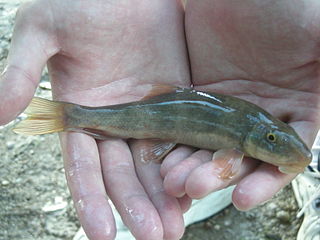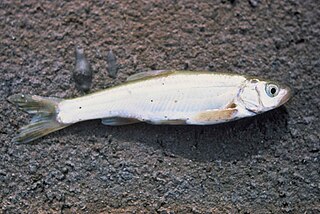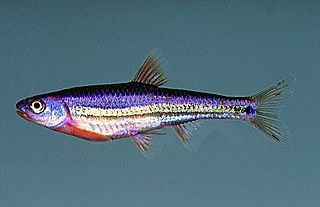
Cypriniformes is an order of ray-finned fish, which includes many families and genera of cyprinid fish, such as barbs, gobies, loaches, botias, and minnows. Cypriniformes is an “order-within-an-order”, placed under the superorder Ostariophysi—which is also made up of cyprinid, ostariophysin fishes. The order contains 11-12 families, over 400 genera, and more than 4,250 named species; new species are regularly described, and new genera are recognized frequently. Cyprinids are most diverse in South and Southeast Asia, but are entirely absent from Australia and South America. At 112 years old, the longest-lived cypriniform fish documented is the bigmouth buffalo.
A dace is a small fish that can be one of many different species. The unmodified name is usually a reference to the common dace. This, like most fish called "daces", belongs to the family Cyprinidae, mostly in subfamily Leuciscinae.

The Virgin River is a tributary of the Colorado River in the U.S. states of Utah, Nevada, and Arizona. The river is about 162 miles (261 km) long. It was designated Utah's first wild and scenic river in 2009, during the centennial celebration of Zion National Park.

Gambusia is a large genus of viviparous fish in the family Poeciliidae. Gambusia contains over 40 species, most of which are principally found in freshwater habitats, though some species may also be found in brackish or saltwater habitats. The genus Gambusia comes from the Cuban term, "Gambusino", which means "free-lance miner". The type species is the Cuban gambusia, G. punctata. The greatest species richness is in Mexico, Texas, and the Greater Antilles, but species are also found elsewhere in the eastern and southern United States, the Bahamas, Central America, and Colombia. Gambusia species are often called topminnows, or simply gambusias; they are also known as mosquitofish, which, however, refers more specifically to two species, G. affinis and G. holbrooki, which are often introduced into ponds to eat mosquito larvae. As a consequence, they have been introduced widely outside their native range, and frequently become invasive, threatening local species. G. affinis and G. holbrooki are now established in many parts of the world and are likely to continue to spread as climatic conditions change. They are only occasionally kept in aquariums, due to their relative lack of color and the highly aggressive nature of the aforementioned mosquitofish species.

Rhinichthys, known as the riffle daces, is a genus of freshwater fish in the carp family (Cyprinidae) of the order Cypriniformes. The type species is Rhinichthys atratulus, the blacknose dace. Rhinichthys species range throughout North America.

Gila is a genus of fish belonging to the family Cyprinidae, native to the United States and Mexico. Species of Gila are collectively referred to as western chubs. The chiselmouth is a close relative, as are members of the genus Siphateles. Several members of the genus are endangered or extinct due to loss of habitat causing by diversion or overuse of water resources, particularly in the western United States.

Catostomus is a genus of fish belonging to the family Catostomidae, commonly known as suckers. This genus of fish usually lives in freshwater basins. Most members of the genus are native to North America, but C. catostomus is also found in Russia.

The northern leatherside chub is a cyprinid fish of western North America.

The Virgin spinedace is a cyprinid fish of the Virgin River, a tributary of the Colorado River in the United States.

Notropis is a genus of freshwater fish in the family Cyprinidae. They are known commonly as eastern shiners. They are native to North America, and are the continent's second largest genus.

Cyprinella is a genus of fish in the family Cyprinidae, the carps and minnows. They are known as the satinfin shiners. They are native to North America, and some are among the most common freshwater fish species on the eastern side of the continent. Conversely, several Cyprinella species with small distributions are threatened and the Maravillas Creek subspecies of the red shiner is extinct.

Erimystax is a genus of ray-finned fish in the family Cyprinidae. Members are commonly known as slender chubs, though "slender chub" is also used for individual species local to some area, particularly Erimystax cahni.

The Little Colorado spinedace is a species of ray-finned fish in the family Cyprinidae. It is found only in Arizona in the United States.
Macrhybopsis, the blacktail chubs, is a genus of cyprinid fish that are found in North America. There are currently 12 species in this genus.
Squalius is a genus of fish in the family Cyprinidae found in Europe and Asia. Hybridization is not rare in the Cyprinidae, including this genus. S. alburnoides is known to be of ancient hybrid origin, with the paternal lineage deriving from a prehistoric species related to Anaecypris; the latter mated with ancestral S. pyrenaicus. Present-day S. alburnoides mates with sympatric congeners of other species.

Leuciscinae is a subfamily of the freshwater fish family Cyprinidae, which contains the true minnows.

Hybopsis is a genus of cyprinid fish endemic to the United States. There are currently six described species in this genus.
Tampichthys is a genus of cyprinid fish endemic to east–central Mexico. They are entirely restricted to the Pánuco River basin, except T. ipni which also occurs in some other Mexican rivers that drain into the Gulf of Mexico.
Siphateles is a genus of fish belonging to the family Cyprinidae, native to the Western United States. They were formerly placed in the genus Gila.

Plagopterinae is a subfamily of the freshwater fish family Leuciscidae, which contains the true minnows. Members of this family are known as creek chubs or the creek chub-plagopterin (CC-P) clade of minnows. All members of this family are found in North America, and it includes among the northernmost-distributed of all North American minnows, the lake chub.















